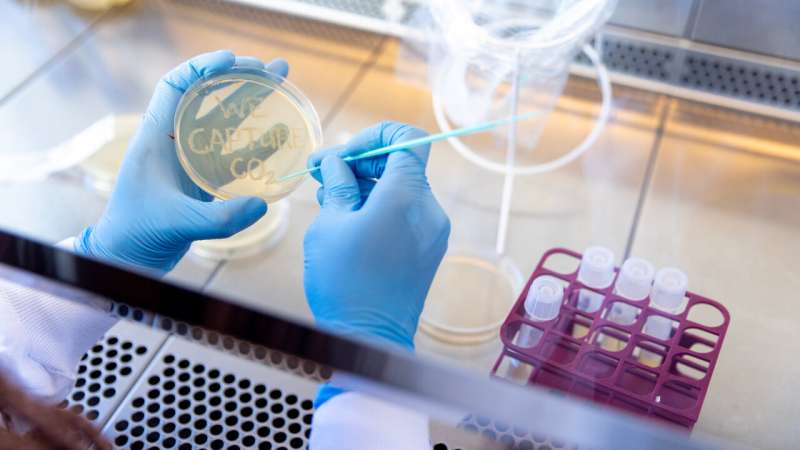Bacteria designed like corals to achieve carbon-neutral cement production

New buildings are often a cause for celebration, but there is not much to celebrate when looking at the climate footprint of the construction industry, which is among the world’s highest.
In 2021 alone, 2.9 billion tons of CO2 were emitted through the industry’s cement production, corresponding to more than 7% of the total global CO2 emissions. The emissions occur when the cement is heated, as the high temperatures cause CO2 release.
Postdoc Colleen Varaidzo Manyumwa and Ph.D. student Chenxi Zhang are working on solving this problem—initially at a micro level. By transferring genes from microorganisms to a particularly tough kind of bacteria, they have succeeded in getting the bacteria to produce an enzyme with a highly sought-after property. The enzyme can quickly and efficiently bind CO2 to limestone, or calcium carbonate, which is one of the main ingredients in cement.
“The process is seen in nature, where ocean corals also capture CO2, but it can take centuries. With our enzyme, it only takes a few minutes,” says Colleen Manyumwa.
The researchers are now working to make the production of the enzyme even more efficient, so their solution can eventually be scaled up and implemented in the industry. The goal is for the cement factories to have a bioreactor with the specially designed bacteria, also called a cell factory, to ensure that the CO2 emitted is captured rather than leaking into the atmosphere.
“It will work a bit like a green circle: The factory releases CO2 during heating, we capture it in the bioreactor, which binds the CO2 to calcium carbonate, the factory then reheats the calcium carbonate to make new cement, and once again we capture the CO2 released,” says Chenxi Zhang.
Corals as a source of inspiration
The ambition to find a circular solution to capture CO2 from a polluting industry is far from unique. But the technology the researchers are working on is very unique and not yet patented.
“Other biologists typically try to design bacteria that mimic photosynthesis, in which plants capture CO2 from the air and convert it into sugar. The problem is that this is very difficult to do. That’s why we chose to say, ‘Forget about plants. We want to mimic corals,'” says Professor Ivan Mijakovic, who is head of the group and came up with the original idea for the project.
Just as plants on land capture CO2 from the air, the ocean’s corals also capture CO2 when they are building the elaborate structures we know as coral reefs. The CO2 is captured in maritime construction, so to speak, which is made of calcium carbonate, just like cement.
“We have genetically engineered the bacteria to behave like ocean corals. Our bacteria also grow underwater, and when the solution is to be scaled up, the cell factory inside the bioreactor will also have to be liquid,” says Ivan Mijakovic.
The researchers can already say now that this sets special requirements for the bioreactor. Because while the cell factory is liquid, the calcium carbonate formed in the reactor is a solid material. In the design phase, it is therefore important to take into account the fact that the solid limestone will need to be transported easily and efficiently out of the reactor.
Huge potential
So far, the solution has only been proven effective in the laboratory, which means that lots of testing is still required to create more results before the researchers can proceed to an actual scale-up.
The main challenge is making the bacteria tough enough to withstand the harsh environment and high temperatures they will be subjected to in the industry. If the researchers succeed with the project, the potential is huge.
“We’ve created a product that can initially be extremely valuable for the construction industry. But since we can create calcium carbonate with our bacteria, we can also create other carbonates that can be used in, for example, the pharmaceutical industry or the papermaking industry. The potential really is huge,” says Colleen Manyumwa.
Although there is still a long way to go from the microorganisms in the laboratory to the final goal, she finds motivation in the big picture of her research.
“Innovation is always challenging, and some days are definitely easier than others. But I believe that within a few years, this solution will exist as one of several solutions to remove CO2 from the atmosphere and help slow down climate change,” she says.
Citation:
Bacteria designed like corals to achieve carbon-neutral cement production (2023, March 9)
retrieved 9 March 2023
from https://phys.org/news/2023-03-bacteria-corals-carbon-neutral-cement-production.html
This document is subject to copyright. Apart from any fair dealing for the purpose of private study or research, no
part may be reproduced without the written permission. The content is provided for information purposes only.
For all the latest Science News Click Here
For the latest news and updates, follow us on Google News.

